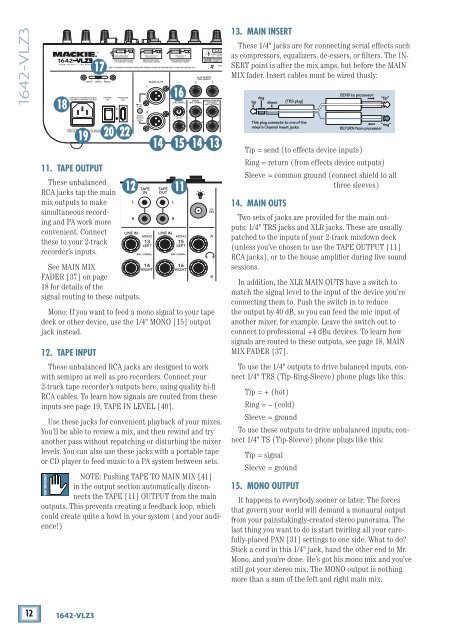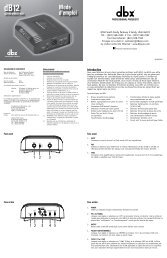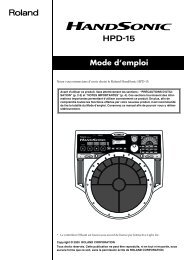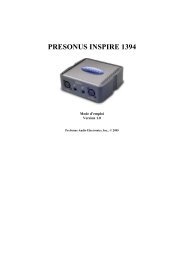1642-VLZ3 16-Channel Mic/Line Mixer Owner's Manual
1642-VLZ3 16-Channel Mic/Line Mixer Owner's Manual
1642-VLZ3 16-Channel Mic/Line Mixer Owner's Manual
You also want an ePaper? Increase the reach of your titles
YUMPU automatically turns print PDFs into web optimized ePapers that Google loves.
<strong><strong>16</strong>42</strong>-<strong>VLZ3</strong><br />
18<br />
17<br />
<strong>16</strong><br />
13. MAIN INSERT<br />
These 1/4" jacks are for connecting serial effects such<br />
as compressors, equalizers, de-essers, or filters. The IN-<br />
SERT point is after the mix amps, but before the MAIN<br />
MIX fader. Insert cables must be wired thusly:<br />
tip ring sleeve<br />
(TRS plug)<br />
SEND to processor<br />
“tip”<br />
19<br />
11. TAPE OUTPUT<br />
20 22<br />
These unbalanced<br />
RCA jacks tap the main<br />
mix outputs to make<br />
simultaneous recording<br />
and PA work more<br />
convenient. Connect<br />
these to your 2-track<br />
recorder’s inputs.<br />
12<br />
See MAIN MIX<br />
FADER [37] on page<br />
18 for details of the<br />
signal routing to these outputs.<br />
14<br />
15<br />
11<br />
14<br />
Mono: If you want to feed a mono signal to your tape<br />
deck or other device, use the 1/4" MONO [15] output<br />
jack instead.<br />
13<br />
12. TAPE INPUT<br />
These unbalanced RCA jacks are designed to work<br />
with semipro as well as pro recorders. Connect your<br />
2-track tape recorder’s outputs here, using quality hi-fi<br />
RCA cables. To learn how signals are routed from these<br />
inputs see page 19, TAPE IN LEVEL [40].<br />
Use these jacks for convenient playback of your mixes.<br />
You’ll be able to review a mix, and then rewind and try<br />
another pass without repatching or disturbing the mixer<br />
levels. You can also use these jacks with a portable tape<br />
or CD player to feed music to a PA system between sets.<br />
NOTE: Pushing TAPE TO MAIN MIX [41]<br />
in the output section automatically disconnects<br />
the TAPE [11] OUTPUT from the main<br />
outputs. This prevents creating a feedback loop, which<br />
could create quite a howl in your system (and your audience!)<br />
This plug connects to one of the<br />
mixer’s <strong>Channel</strong> Insert jacks.<br />
Tip = send (to effects device inputs)<br />
Ring = return (from effects device outputs)<br />
Sleeve = common ground (connect shield to all<br />
three sleeves)<br />
14. MAIN OUTS<br />
Two sets of jacks are provided for the main outputs:<br />
1/4" TRS jacks and XLR jacks. These are usually<br />
patched to the inputs of your 2-track mixdown deck<br />
(unless you’ve chosen to use the TAPE OUTPUT [11]<br />
RCA jacks), or to the house amplifier during live sound<br />
sessions.<br />
In addition, the XLR MAIN OUTS have a switch to<br />
match the signal level to the input of the device you're<br />
connecting them to. Push the switch in to reduce<br />
the output by 40 dB, so you can feed the mic input of<br />
another mixer, for example. Leave the switch out to<br />
connect to professional +4 dBu devices. To learn how<br />
signals are routed to these outputs, see page 18, MAIN<br />
MIX FADER [37].<br />
To use the 1/4" outputs to drive balanced inputs, connect<br />
1/4" TRS (Tip-Ring-Sleeve) phone plugs like this:<br />
Tip = + (hot)<br />
Ring = – (cold)<br />
Sleeve = ground<br />
To use these outputs to drive unbalanced inputs, connect<br />
1/4" TS (Tip-Sleeve) phone plugs like this:<br />
Tip = signal<br />
Sleeve = ground<br />
“ring”<br />
RETURN from processor<br />
15. MONO OUTPUT<br />
It happens to everybody sooner or later: The forces<br />
that govern your world will demand a monaural output<br />
from your painstakingly- created stereo panorama. The<br />
last thing you want to do is start twirling all your carefully-placed<br />
PAN [31] settings to one side. What to do<br />
Stick a cord in this 1/4" jack, hand the other end to Mr.<br />
Mono, and you’re done. He’s got his mono mix and you’ve<br />
still got your stereo mix. The MONO output is nothing<br />
more than a sum of the left and right main mix.<br />
12 <strong><strong>16</strong>42</strong>-<strong>VLZ3</strong>
















